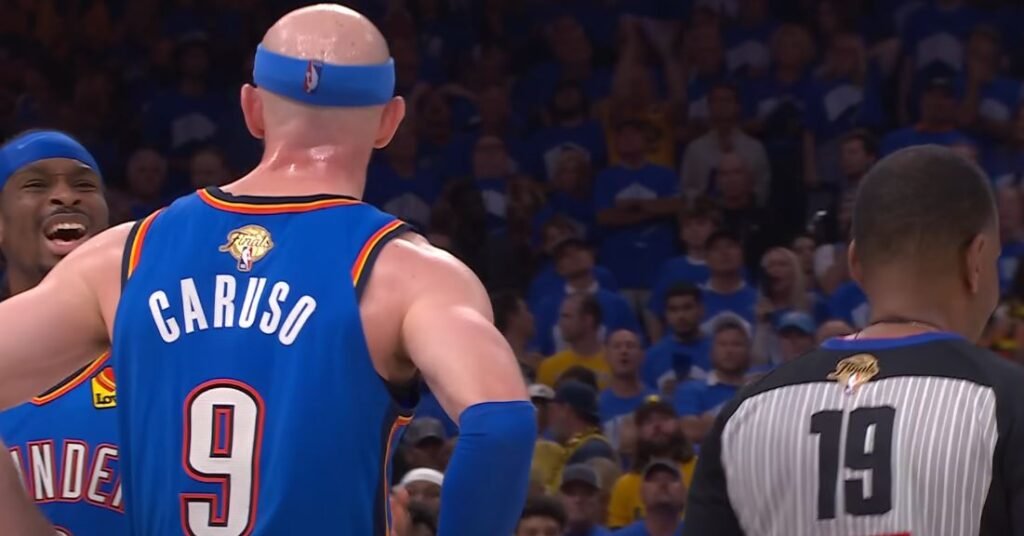
This season’s salary cap situation for the Oklahoma City Thunder is an example of measured ambition. Their payroll is so close to the luxury tax that it feels like a needle threading under stadium lights, barely missing the cap. This kind of strategic restraint, which combines strategic vision with disciplined execution to rival the most astute financial portfolios, is uncommon in professional sports.
They have made a statement without sacrificing flexibility by securing $822 million extensions for Shai Gilgeous-Alexander, Jalen Williams, and Chet Holmgren. It’s a very creative approach that rewards core talent well while arranging agreements to give the team flexibility under harsh apron restrictions. In a league where overstretching frequently cripples teams before they can fully utilize their talent, this strategy works remarkably well.
Oklahoma City Thunder – 2025-26 Salary Cap & Contract Overview
| Category | Details |
|---|---|
| NBA Salary Cap 2025-26 | $154,647,000 |
| Active Roster Payroll | $186,877,564 |
| Luxury Tax Threshold | $187,900,000 |
| Room Below Tax Line | $1,022,436 |
| Total Allocations | $193,023,046 |
| First Apron Space | $8,567,436 |
| Second Apron Space | $20,446,436 |
| Largest Guaranteed Contract | Alex Caruso – $81,096,960 |
| Big 3 Extensions | $822 million total (Gilgeous-Alexander, Williams, Holmgren) |
Given his MVP-caliber dominance, Gilgeous-Alexander’s $38.3 million salary seems like a steal. Last season, his 32.7 points per game weren’t just stats; they were performances that changed the course of the game and helped the team get through difficult postseason runs. His presence makes everything around him sharper, more self-assured, and noticeably better, much like the gravitational pull of a star CEO.
The Thunder’s commitment to long-term development is exemplified by Jalen Williams, who is currently on a maximum rookie extension. His 40-point performance against Indiana in the Finals was not an anomaly; rather, it was a sneak peek at what he could provide in his prime. Despite having few games, Holmgren‘s $250 million extension is a daring but incredibly effective investment in potential, evoking the days of innovative startups placing bets on cutting-edge technology before it becomes widely used.
Carefully woven into this financial architecture are even role players. Alex Caruso’s $81 million guaranteed contract is more about cultural value than box office impact. Like a seasoned operations chief who prevents a high-growth company from burning out under rapid expansion, his defensive edge and leadership stabilize the roster.
One particularly advantageous aspect of the Thunder is their contract layering. They have created a structure that permits ongoing adaptation by introducing non-guaranteed years and varying player options. This reflects the flexibility of elite investment funds, which can change their assets in response to market fluctuations without compromising their core holdings.
The impact is equally important from a societal perspective. Sustainable roster management fosters trust in a smaller market where the franchise becomes ingrained in the local culture. Supporters are aware that their team isn’t pursuing fleeting fame at the price of ten years of relevance. It’s a civic guarantee, similar to a neighborhood organization pledging to grow responsibly without sacrificing excitement.
Executives in the NBA are paying attention. Due to their own cap blunders, teams like Phoenix and Brooklyn have faltered, losing draft capital and flexibility. The league’s new financial realities have made Oklahoma City’s prudent spending a model for how to prosper. ESPN’s Bobby Marks has gone so far as to call their model a blueprint for small-market teams hoping to compete with their well-funded rivals.
With a projected payroll of $246 million for 2026–2027, they will surpass both aprons. However, they still have the flexibility to change course with $77 million in non-guaranteed contracts. They can either bolster the roster or create room for a seismic trade without being financially paralyzed thanks to that kind of flexibility.
Though the quieter victory is in the books, their 2025 championship win will be remembered for the skill on the court. The Thunder have demonstrated that a team can reward its contributors, retain its stars, and create opportunities for the future with vision, structure, and frugal spending. Oklahoma City has discovered the sweet spot, where ambition and caution meet, where a dynasty can be established without ever taking out a loan for the future. This is in an industry that rewards audacity but penalizes recklessness.
